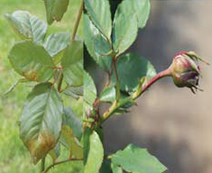 Rose growers have a relatively benign group of insect pests to deal with and so focus most of our pesticidal attention on the fungal disease -- powdery mildew -- that seem to bedevil us on a yearly basis. However, every few months, we are confronted with a far more virulent fungicidal invader known as downy mildew. Downy mildew is a fairly common term as far as plant diseases go.
Rose growers have a relatively benign group of insect pests to deal with and so focus most of our pesticidal attention on the fungal disease -- powdery mildew -- that seem to bedevil us on a yearly basis. However, every few months, we are confronted with a far more virulent fungicidal invader known as downy mildew. Downy mildew is a fairly common term as far as plant diseases go.
Downy mildew disease poses an increasing problem in the horticultural industry causing serious losses in many floricultural and greenhouse crops.Downy mildews present a challenge to growers both because the disease can be present but not obvious; and because they are difficult to control with fungicides once established. The pathogens are very different from Powdery Mildews- they attack different plants under very different environmental conditions, and are controlled by different classes of fungicides. Downy Mildew diseases are caused by a group of fungus-like organisms: they are not true fungi, and are similar to Pythium andPhytophthoraspecies. Most of the Downy mildew fungi are host specific and infect only one plant family.
Symptoms of Downy Mildew
Rose downy mildew is remarkably variable. In the past 20 years the most common symptom has been angular, tan spots with a very small amount of white crystalline sporulation on leaf undersides. The name of the pathogen —Peronosporasparsa— reflects the sparse production of white spores. Sometimes collapsing buds or cankers form on newly emerging rose canes. Different species and cultivars of roses respond differently to downy mildew, making a diagnosis very difficult. Severe leaf drop is common on some cultivars. Tiny speckles may form that are tan or even bright pink. Downy mildew start as yellow to light green, irregular leaf lesions which can become purple to dark brown and be delimited by leaf veins. Under humid conditions, the fungus sporulates on leaf undersides, producing white, tan, gray or purple, downy growth.
Downy mildews reproduce through special structures called sporangia that develop on leaf undersides. Air currents and splashing water dislodge these sporangia which then infect nearby healthy plants. Symptoms will vary along with the host plant and Downy mildew pathogens vary in aggressiveness. As the disease progresses, lower leaves can wither and fall off. The fungus grows both locally and systemically and it can escape notice until conditions are right for sporulation. Systemic symptoms can include stunting, leaf distortion and epinasty, shortened internodes, and a decrease in the quantity and quality of flower production.Some downy mildews produce long lasting survival spores (Oospores) that can persist in the soil indefinitely. These diseases thrive under the cool, wet conditions, generally favored by cool temperatures (15-23° C). Downy mildews need wet leaves and high relative humidity (greater than 85 %) to cause disease; under these conditions, disease can occur very rapidly and is difficult to control.
Controlling Downy Mildew
The best control of downy mildew is to make sure that your plants do not get it in the first place. Growers should provide the required cultural conditions for healthy plant growth and development. Preventing the introduction of downy mildew pathogens into the greenhouse is of primary importance. Plants should only be purchased from reputable and trusted sources and should be thoroughly inspected before their introduction into production areas. Cultural management practices for Downy mildew diseases consist of managing relative humidity in the greenhouse, strict sanitation, and preventive fungicide applications. It is critical to keep relative humidity below 85 % to decrease sporulation on infected plants and stop germination of spores on healthy plants. This can be done by venting and heating, which fills the greenhouse with warm, drier air. The use of fans in greenhouses improves horizontal air flow and prevents cold spots where condensation develops from occurring. The density of the plant canopy should be reduced by spacing plants to allow for maximum air circulation and sunlight availability. Greenhouses should be scouted regularly for the first symptoms of the disease to achieve effective control with fungicide applications. Diseased plants, infected debris, and soil should be promptly removed and destroyed.
Fungicides should be applied preventively for maximum efficacy. The highest levels of control are obtained when fungicides are applied preventively.Many products which give excellent control preventively result in less or no control when used as curatives; once sporulation occurs control is difficult to impossible. The use of fungicides to control downy mildew diseases has become more difficult because of the development of fungicide resistant strains of downy mildew pathogens and concurrent loss of effectiveness. Most products with systemic activity are subject to an anti-resistance strategy. These measures include: beginning a regular spray program with a protectant fungicide, limiting the number of applications of particular fungicides applied per season, rotating fungicide applications among FRAC groups (modes of action), applying systemic chemicals in combination with a protectant ones.
To counteract resistance, BASF has introduced Orvego® 525SC whose activity is superior in Downy mildew control.
Orvego® 525SC is a versatile element for your downy mildew spray program that maximizes the marketable yields of your crops – for all markets worldwide. It has dimethomorph and Initium™ (Ametoctradin) that stops the flow of energy in the fungus like a valve stops the flow of fuel in a pipe as well as no cross resistance observed with other chemical classes. Initium is an innovation breakthrough by BASF and forms a very vital tool for resistance management as it’s in a class of its own.


